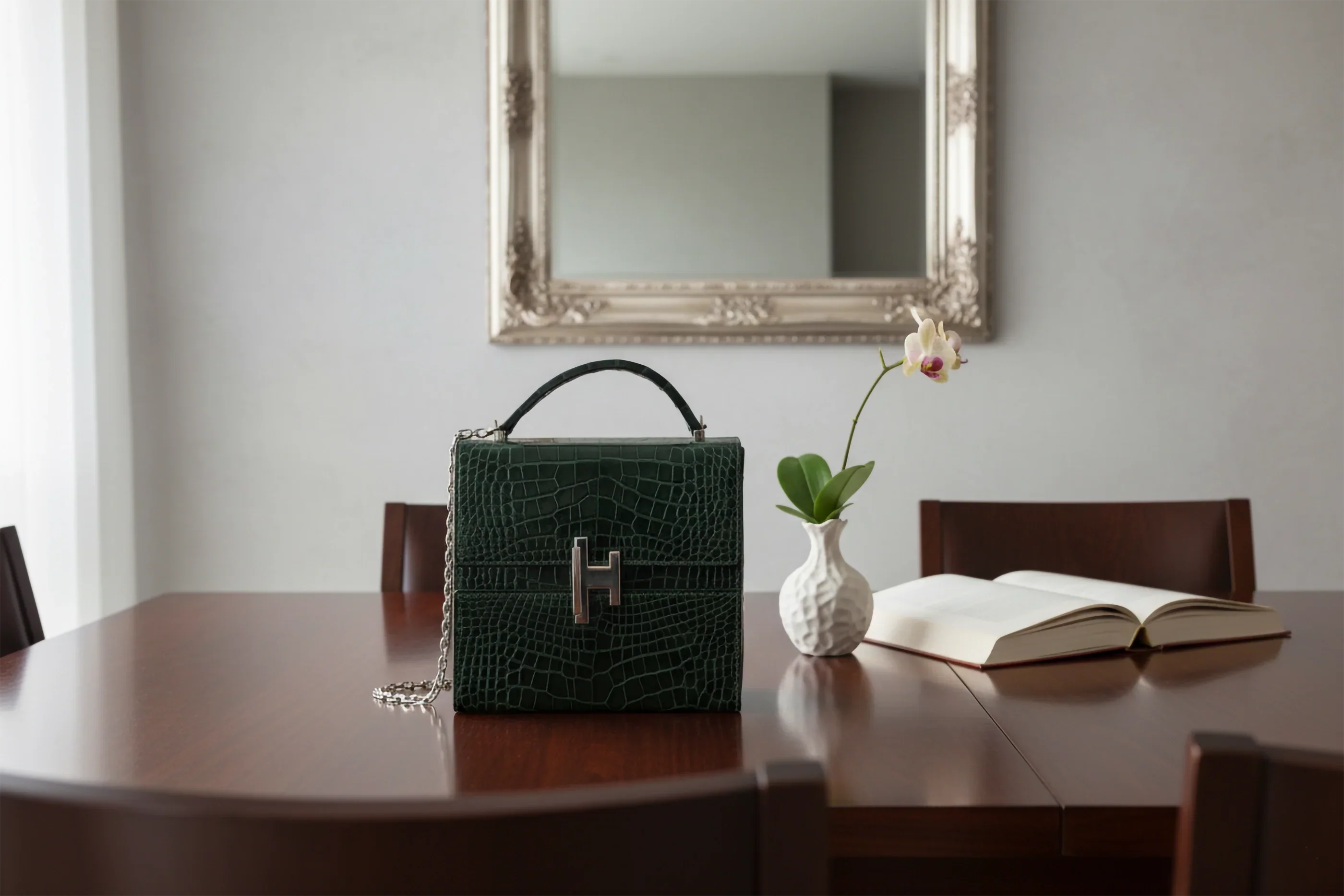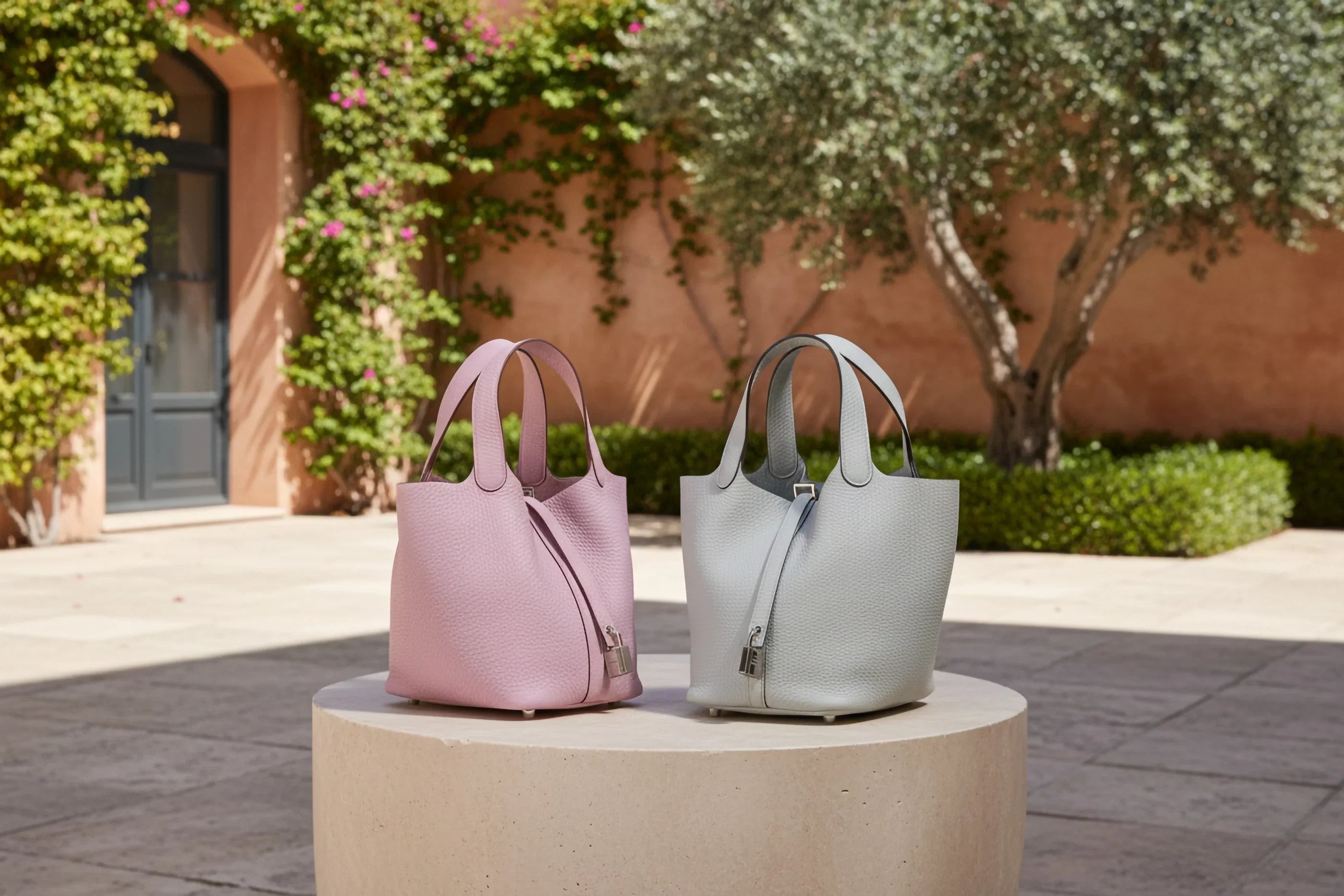
The Hermès Atelier: Inside the Luxury Bag-Making Process
Check out our Hermès collection and Birkin bags!
When you hear the name Hermès, you probably picture timeless elegance and a level of craftsmanship that’s hard to rival. The Hermès atelier offers a rare peek behind the curtain, showing how each luxury bag comes together, step by step, with an almost obsessive attention to detail. Sure, there’s status involved, but these handbags are really about tradition, artistry, and a stubborn insistence on quality that’s become pretty rare.
Let’s see how artisans turn premium materials into some of the world’s most coveted accessories, one careful stitch at a time. Along the way, you’ll meet some of the craftspeople, catch a glimpse of what goes into each creation, and maybe pick up on a few reasons these bags feel so special.
Key Takeaways
- Hermès bags come to life through careful, step-by-step artistry.
- Every stitch and detail gets serious attention.
- Skilled artisans and ethical methods keep the brand’s standards sky-high.
The Hermès Atelier: An Icon of Luxury Craftsmanship
Not many maisons capture the imagination quite like Hermès. Its bags show off time-honored techniques, signature designs, and the devoted hands that make every iconic piece.
History of Hermès Bag-Making
Hermès began in Paris in 1837 as a harness and saddle workshop for the French aristocracy. The legacy of meticulous leatherwork started with equestrian gear, and you can still see that attention to detail today.
In 1922, Émile-Maurice Hermès introduced the first leather handbag after his wife asked for something more practical. By the middle of the 20th century, the Kelly (famously carried by Grace Kelly) and the Birkin (co-designed with Jane Birkin) had become fashion legends.
Each bag’s evolution shows Hermès’ commitment to both heritage and innovation. The brand still makes everything in its French ateliers, so tradition and artistry get passed down through generations.
Signature Styles and Iconic Models
Hermès bags stand out with their classic lines and subtle branding. The Birkin and Kelly are the obvious stars, but models like the Constance, Evelyne, and Lindy have their own loyal followings.
Here’s a quick comparison of three icons:
| Model | First Released | Distinctive Feature | Often Available In |
|---|---|---|---|
| Kelly | 1930s | Single top handle, lock | Togo, Swift, Epsom |
| Birkin | 1984 | Dual handles, open top | Clemence, Togo |
| Constance | 1959 | “H” clasp, shoulder bag | Epsom, Swift |
What really sets these bags apart is their understated luxury: hand-stitched seams, top-tier hardware, and leathers sourced from the best tanneries. Owning one isn’t just about fashion, it’s about appreciating subtlety and real craftsmanship.
The Role of Artisans in Preserving Heritage
Artisans are the soul of Hermès. One artisan crafts each bag from start to finish, a process that can take 20 hours or even longer.
Training takes years. Apprentices have to master saddle-stitching and edge-dyeing before they’re trusted with a Kelly or Birkin. If there’s a mistake, it gets rejected, only bags that pass strict standards reach the boutiques.
Skills get handed down in the ateliers, so Hermès becomes a guardian of traditional French leatherwork. This personal touch, with all the pride and expertise behind it, makes every Hermès bag a true one-off, a little piece of heritage and skill you can hold.
Step-by-Step Inside the Bag-Making Process
Every Hermès bag starts with a series of carefully orchestrated steps, from hand-selecting leather to those intricate stitches. Each stage blends old-school skill and a sharp eye for quality, making every bag unmistakably Hermès.
Sourcing and Selecting Premium Materials
It all begins with picking out the best hides, Togo, Clemence, or sometimes exotic skins. Artisans inspect each hide by hand and eye under natural light. Flaws, scratches, weird marks? Those get tossed aside.
They check for feel, pores, and suppleness, since those details shape the bag’s final character. Hermès relies on long-standing relationships with trusted tanneries.
This focus on material quality isn’t negotiable. Every bag starts as a piece of leather that already meets a nearly impossible standard.
Pattern Creation and Preparation
Making a Hermès bag means every part needs its own custom template, down to the smallest pocket or strap. Artisans create stencils and patterns for each style, so everything lines up perfectly.
They trace these patterns onto the leather with a light, washable pencil. There’s even a pattern archive that stretches back decades.
Patterns get tweaked for each batch, style, and leather type. Prep also involves marking where hardware, handles, and personal touches will go. Getting this right early on saves hours, and a lot of headaches later.
Cutting and Shaping Leather
Once everything’s marked, it’s time to cut. Using half-moon knives and other specialized tools, artisans cut each piece by hand to avoid waste. No industrial presses here.
Edges might get trimmed or moistened for thicker leathers, keeping the final bag sleek. Rulers and guides help keep dimensions spot on.
Every cut piece gets inspected again. If it doesn’t make the grade, it’s out. Pieces are gently bent or pressed to encourage the right shape, depending on the bag style.
Hand Stitching Using the Hermès Saddle Stitch
Stitching is where the magic happens. The saddle stitch uses two needles and a single length of waxed linen thread. Each hole is pre-punched with an awl for accuracy.
Both needles cross in opposite directions, making a seam that won’t unravel, even if one thread snaps. Here’s a visual breakdown:
| Step | Tool Used | Why It Matters |
|---|---|---|
| Punching holes | Awl | Ensures consistent spacing |
| Threading | Needles (2) | Even, balanced stitches |
| Waxing thread | Beeswax | Adds strength and longevity |
| Stitching | by hand | Durability and aesthetics |
This stitch isn’t fast. It demands patience, but the seam ends up strong, flexible, and honestly, kind of beautiful. It’s a big reason why these bags can last for decades (or, let’s be real, maybe forever).
Meticulous Attention to Detail: Every Stitch Counts
The creation of a Hermès bag is about precision, and that means sweating the small stuff. From the way the leather’s edge gets painted to the satisfying click of a clasp, every part is treated like it matters.
Edge Painting and Finishing Touches
Painting the leather’s edges might sound easy, but it’s anything but. Artisans carefully sand, tint, and layer edge paint with tiny brushes. Each coat dries, then gets sanded smooth and checked for evenness. If the edge isn’t perfect, they start over.
This process protects the leather and gives the bags their seamless finish. Sometimes, contrasting or complementary colors make the edges pop. It can take hours for just one bag, but skipping steps isn’t an option.
Finishing touches go even further: hand-buffed surfaces, painted monograms, subtle hot-stamping. Even the stitches get waxed for durability and a little shine, because every millimeter counts.
Metal Hardware Assembly
Once the leather’s ready, it’s time for hardware. Each clasp, lock, and rivet goes on by hand. Artisans use special tools for every hinge and screw. Anything off-center or loose? It’s out.
Hermès insists on solid brass or palladium-plated hardware. Every metal piece gets checked with a magnifying glass for scratches or blemishes before being attached. There’s even a checklist for things like Hermès engraving depth and alignment, because who wants a crooked logo?
Assembly isn’t rushed. If something needs adjusting, it’s done by hand. Every visible part gets polished to a mirror finish. Maybe it’s a little fussy, but that’s luxury for you.
Quality Control and Final Inspection
Before a bag leaves the atelier, it goes through a multi-step inspection. Seams, handle attachment, symmetry, leather texture, stitching, everything gets checked. If something’s off, back it goes for fixing.
Checklist includes:
- Stitch count per inch
- Edge paint consistency
- Hardware movement and shine
- Symmetry of all pieces
Other steps include using gloves to check for surface imperfections and even smelling the leather to make sure it’s the real deal. Only after passing every check does the bag go into its dust cover. That orange box? It’s earned.
Meet the Artisans: Masters Behind Each Bag
At Hermès, every bag comes from skilled hands blending tradition with meticulous care. The journey to becoming a Hermès artisan is demanding, and it shows in the bags we love.
The Four-Year Hermès Training Journey
To craft a single Hermès bag, an artisan trains for at least four years. It’s not just about learning to stitch leather, it’s about developing an eye for quality and symmetry. Trainees start in the Hermès École, working beside seasoned masters and slowly refining their skills.
They train their hands to “feel” the leather, judging softness, grain, even scent. They’re tested through dozens of steps: hand-stitching, edge painting, cutting. Only those who meet Hermès’ exacting standards make it to the workbench.
A typical day? Hours bent over a bench, tools sometimes given affectionate nicknames, and a quiet pride in every finished piece.
Meet Individual Craftspersons
Each Hermès artisan brings their own touch and pride to every bag. Some come from families of leatherworkers, others from totally different backgrounds, but all share a laser focus on detail. Some have made the same bag style for decades, the iconic Birkin or Kelly, for example.
Spotlight on a few roles in the atelier:
- Maître maroquinier (master leatherworker): oversees the process and mentors new artisans.
- Stitching specialists: hand-sew seams with waxed linen thread using the saddle stitch.
- Finishing experts: perfect the edges, using heat and layers of dye and wax.
Sometimes, artisans quietly initial a hidden spot inside the bag, their secret signature.
Tradition and Innovation in Technique
Hermès artisans respect centuries-old methods and still embrace new ideas. The double-needle saddle stitch, impossible to replicate by machine, is at the heart of every bag. Awls, wooden blocks, even vintage tools passed down through generations get regular use.
Recently, precision lasers help with pre-cutting templates. This means each piece fits with near-mathematical accuracy, but the actual bag-making is still all by hand. Artisans experiment with new leathers and hardware, staying rooted in tradition but always open to subtle improvements.
Sustainability and Ethical Practices at Hermès
Sustainability matters, and Hermès has set a high bar for ethical craftsmanship. By using responsible materials and focusing on care, the brand helps preserve both style and the planet.
Responsible Sourcing
Every bag starts with carefully chosen raw materials. Hermès works only with partners who meet strict environmental and ethical standards. Leathers come from tanneries certified by the Leather Working Group, ensuring traceability and less environmental impact.
Suppliers must follow codes of conduct around animal welfare, with audits and site visits to keep things in check. Silk and other textiles also have to meet tough sustainable sourcing guidelines.
For transparency, Hermès publishes reports on supply chain practices and joins multi-brand initiatives to improve industry standards for people and the environment.
| Sourcing Criteria | Focus |
|---|---|
| Leather | Certified tanneries, traceable |
| Silk & Textiles | Responsible farming practices |
| Supplier Audits | Animal welfare & ethics |
Longevity and Repair Services
A big part of Hermès’ philosophy is making bags that last. After-sales services cover repairs, refurbishment, and even full restoration by trained artisans. It’s not unusual to see a Birkin or Kelly passed down for generations and still turning heads.
Hermès encourages owners to invest in regular care and offers tips for storage and cleaning. The repair workshops handle everything from minor touch-ups to full linings or handle replacements.
This commitment to product lifespan cuts down on waste and reinforces the Hermès approach: buy less, buy better, and care more. For a lot of people, being able to repair rather than replace is a huge part of the joy of owning these timeless pieces.
Exclusive Bag Customizations and Special Orders
If you’ve got an eye for personal style (and maybe a bit of a Hermès obsession), the brand’s custom options are a whole different world. Their bespoke services and special editions let you put your stamp on luxury, making every piece feel like it’s got a bit of your story woven in.
Bespoke Orders at Hermès
Ordering bespoke at Hermès means you get to dream up a handbag that’s really yours. You pick from leathers like Togo, Epsom, Swift, or go wild with exotics, crocodile, ostrich, you name it. Each one feels different in your hand, comes in its own palette, and, honestly, some are fussier to care for than others. There’s a lot to consider, but that’s half the fun.
Customisation isn’t just about the leather, either. You can choose the stitching, hardware finishes (gold, palladium, rose gold, it’s a tough call), and even ask for hand-painted initials or a special motif. The Horseshoe Stamp is the quiet telltale of a custom Hermès, and collectors definitely notice.
Working with Hermès artisans is a real collaboration. You’ll talk through your wish list, touch sample swatches, and sign off on every detail before they get to work. It can take a year or two, so patience is part of the deal. But honestly, that wait just adds to the excitement.
Limited Editions and Collaborations
Every now and then, Hermès drops limited edition bags or teams up with artists and designers. These are the unicorns, bags with wild themes, rare leathers, or hardware you just won’t find in the standard lineup.
Think seasonal colors, unexpected prints, or details like embroidery and beadwork. Collaborations with people like Aline Honoré or jeweler Pierre Hardy have produced some seriously collectible pieces.
Getting your hands on one? Not so easy. You need timing, luck, and, let’s be real, a good relationship with your Hermès boutique. For those who chase exclusivity and artistry, these drops are irresistible. They definitely stir up some buzz.
Behind the Scenes: The Hermès Atelier Experience
Step into the Hermès atelier and you feel it, artistry, focus, and a kind of hush that says something special’s happening here. From first sketch to final polish, every move is about getting it exactly right.
Touring the Workshop
Walking through the atelier, the vibe is almost zen. Workstations are tidy, tools sit just so, and the only sounds are quiet: a blade slicing leather, a needle sliding through. It’s not frantic. It’s careful, and you can tell everyone is deeply into their craft.
Small teams handle each stage of the process. Maybe you’ll spot a saddler hand-stitching, or someone else picking the perfect hide. The lighting is soft, easy on the eyes, making it easier to catch tiny flaws before they become problems.
Sometimes, a master artisan steps over to check a piece, no drama, just a quick look to make sure it’s up to Hermès standards. Nobody’s in a hurry. Quality always wins out over speed.
Life in the Atelier
Artisans here don’t just clock in and out. They spend years learning, shadowing mentors, and picking up skills that feel more like family heirlooms than job training.
One craftsperson usually takes a bag from start to finish. That’s rare, and it means there’s real pride in every piece. Lunch breaks turn into mini seminars about leather or a tricky new stitch someone finally perfected.
A tradition that’s easy to love: each bag gets stamped by its maker. It’s a small mark, but it ties a real person to a bag that might become someone’s prized possession. Here, it’s not just about making luxury goods, it’s about legacy, and being part of the Hermès story.
Frequently Asked Questions
It’s hard not to be fascinated by Hermès bags, their construction, the secrets, the whole aura. Let’s untangle some of the most common questions, toss in a few little-known facts, and maybe clear up how to actually get your hands on a Birkin.
What steps are involved in crafting a Hermès luxury bag?
Every Hermès bag starts with a careful pick of premium or exotic leathers. Skilled artisans cut, shape, and hand-stitch each piece using the signature saddle stitch.
It’s all hands-on. A Birkin or Kelly can take up to 48 hours. The same craftsperson handles the finishing touches, like edge dyeing and attaching hardware, from start to finish.
Where exactly are Hermès bags constructed, and can visitors tour the factories?
All Hermès bags are made in French workshops, places like Pantin, Ardennes, and Alsace. These factories run on tradition and tight-knit teamwork.
Sorry, though: the workshops aren’t open for tours. Privacy is key, both for the artisans’ focus and to keep Hermès’ methods under wraps.
How do Hermès artisans ensure the exclusivity and quality of each bag?
A single artisan crafts each bag, managing every step from stitching to polishing. This way, every detail gets the same careful attention.
Quality checks are strict. Bags are inspected more than once to make sure they meet the standard, but you’ll still spot the maker’s unique stamp, a little human touch that says, “I made this.”
What's the real scoop on the rarity of the Birkin bag, and is it possible to buy one on the spot?
The Birkin’s reputation for being rare isn’t just marketing. Production is tight, and demand is wild. You won’t see Birkins on the shelf. Buying one usually means an invite or a waitlist.
So, no, you can’t just stroll in and grab a Birkin. Sometimes the wait is months, or even years. But maybe that’s part of the thrill?
Which exotic materials does Hermès use for their high-end bags, and how are they sourced?
Hermès uses exotics like crocodile, alligator, lizard, and ostrich for its top-tier bags. They source these skins responsibly, with strict rules about sustainable farming, especially for endangered species.
Every exotic-skin bag comes with a CITES (Convention on International Trade in Endangered Species) certificate, so you know it’s legal and ethically sourced.
Could you give us a glimpse into the role of the Hermès creative director in the bag-making process?
The creative director shapes the vision for each new collection, picking out colors, experimenting with shapes, and dreaming up unexpected design details. They work right alongside the craftspeople, sometimes nudging, sometimes just listening, offering feedback but never steamrolling the traditional skills that make Hermès what it is.
It’s a tricky balance: honoring all that heritage while still sneaking in a bit of innovation. Sure, the Birkin or Kelly bags look timeless, but there’s always a twist or a wink tucked somewhere you might not expect.




